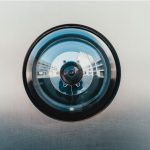Even though the average number of car body repairs is decreasing, the value of the industry seems set to increase in the coming years. Body repair is a specialist corner of the car repair field, with specialist tools to carry out fixes. Whether you’re interested in opening your own repair shop or simply curious, this article will show you ten of the most common tools you’ll find in a body repair shop.

Air Compressor
An air compressor is a necessary piece of equipment for body shops that offer re-painting services. The compressor “powers” the spray guns (mentioned next) used to re-coat panels and car parts, providing even air-flow and a cheaper alternative to canned compressed air.
Spray Gun
Spray guns, otherwise known as High Volume Low Pressure (or HVLP) spray guns are primarily used in body shops for re-painting panels on cars; they produce even and robust coverage, avoiding the chance of splotches or running.
Angle Grinder
Angle grinders are commonly used in body shops to remove paint from a vehicle without affecting the base metal beneath, as well as removing rust from the wheel arch and chassis; cordless angle grinders enable body shop mechanics to access hard-to-reach areas around and under the car, and are easily adapted for different use cases.
Autobody Hammer and Dolly Set
These are a specialist set of tools for car body repair, designed for reshaping bent body panels back into shape. The kit comprises various “dollies”, metal peening tools to deform and reform metal sheeting, and hammers of different sizes to apply different levels of force.
Dual Action Sander
Dual action sanders are small, lightweight power sanding tools which are used by mechanics to quickly sand down body panels and surfaces. The most common use case is in scenarios where body filler has been used to even out panels or doors that suffered perforation damage.
Slide Hammer
A slide hammer is a hammering tool used to straighten metal and pull dents out of sheets, but can be used even in hard-to-reach areas. The impact force is transferred via a heavy sliding handle, along a metal pole to a rubber stop at the end.
Sanding Blocks
Sanding blocks are used where dual action sanders would struggle to access, or be otherwise too heavy handed. Where small applications of body fill putty have been used, sanding blocks can form the filler into the correct contour manually.
Stud Welder
A stud welder is a welding tool designed for welding rods and shims to larger surfaces. They are often found in body shops as a means of correcting significant dents in bodywork; a large-diameter rod is welded to the bare metal of the panel, and pulled to correct it. The rod is then sawn off and the remnants sanded back down.
Suction Cup Dent Pullers
Suction cup dent pullers present a less destructive way to correct smaller dents and dings in car bodies. The suction cup attaches to the dent in question, and the mechanic pulls on the tool to correct the dent.
Putty Knives
Putty knives are the easiest and most efficient way with which to apply body filler; much like pallet knives in painting, they are used to dose and shape the filler in perforations or cracks of various sizes.







